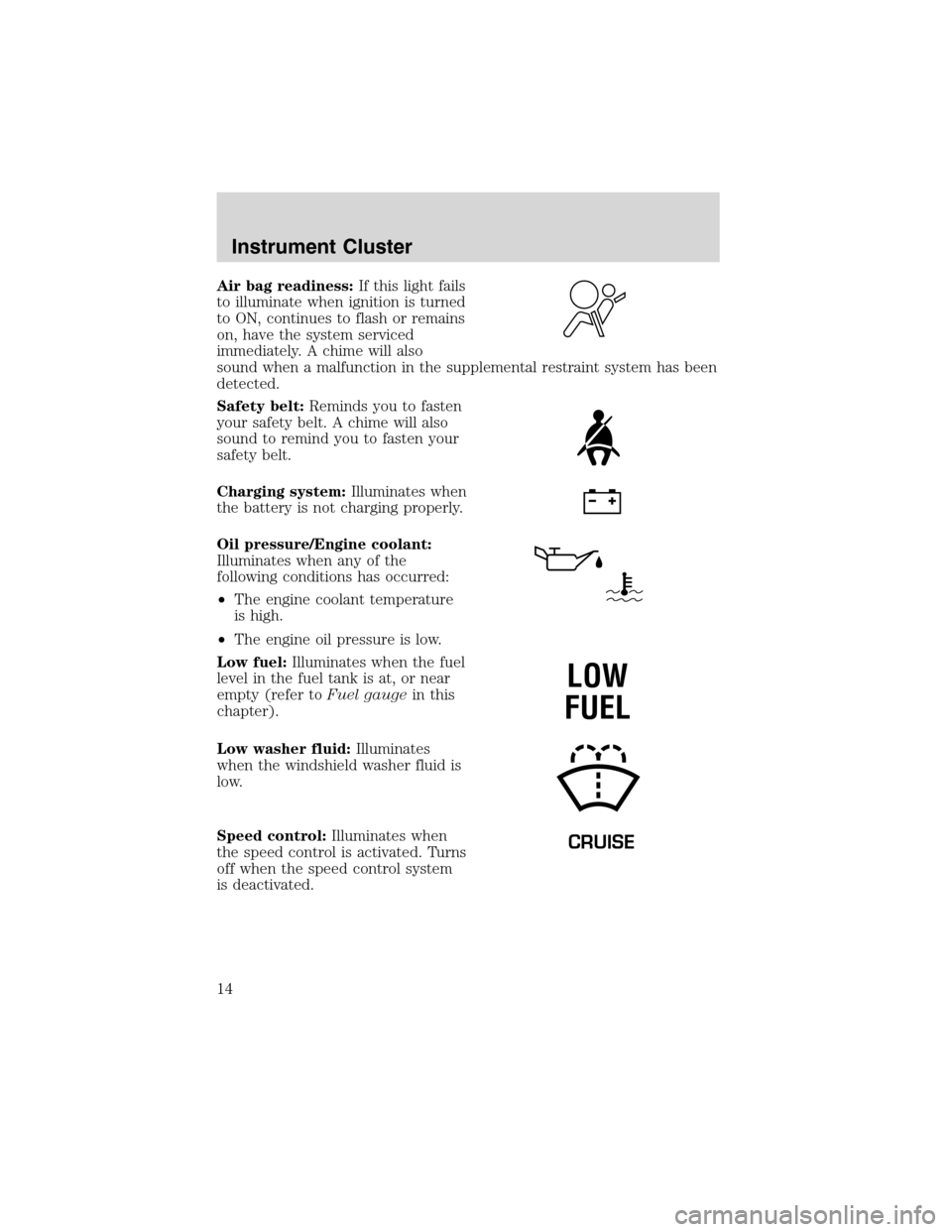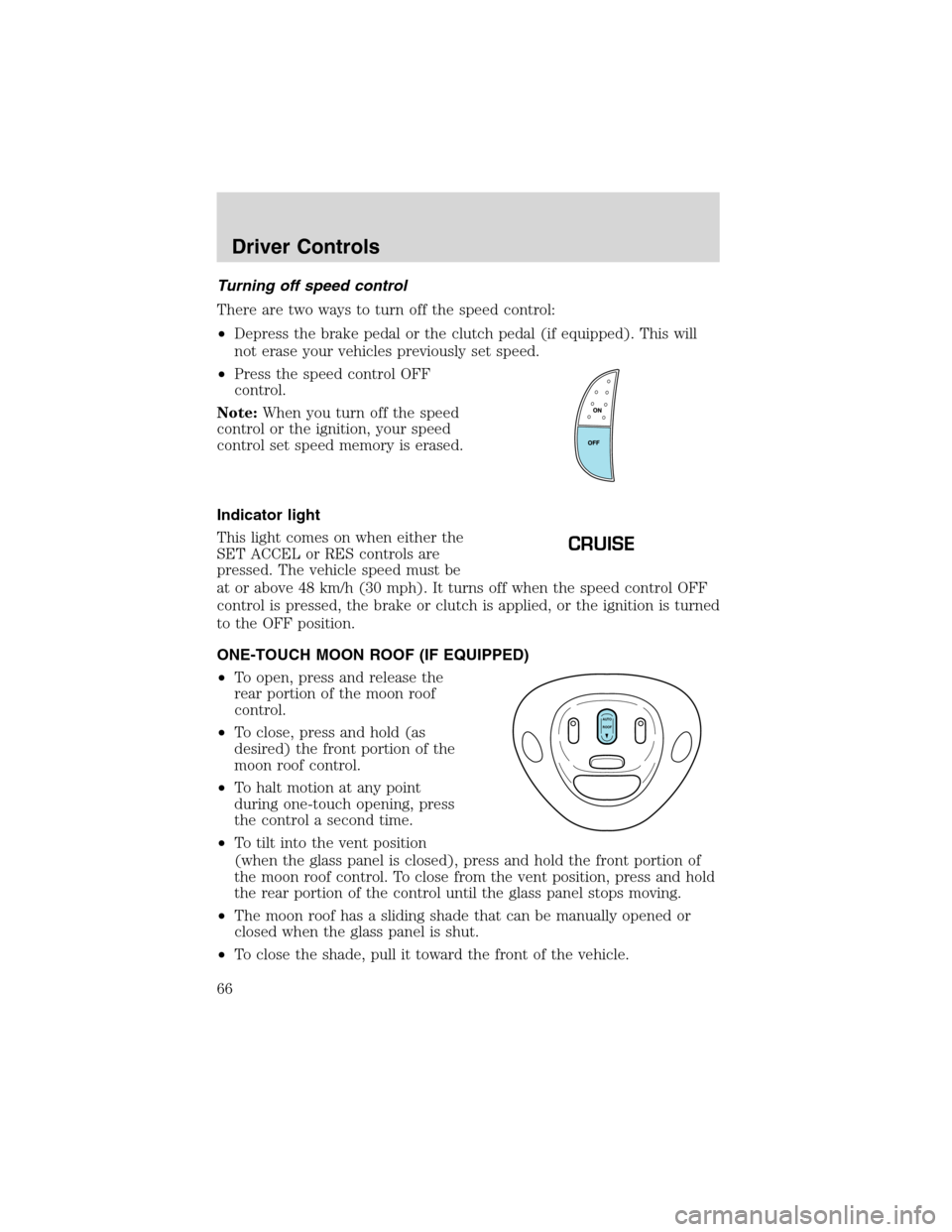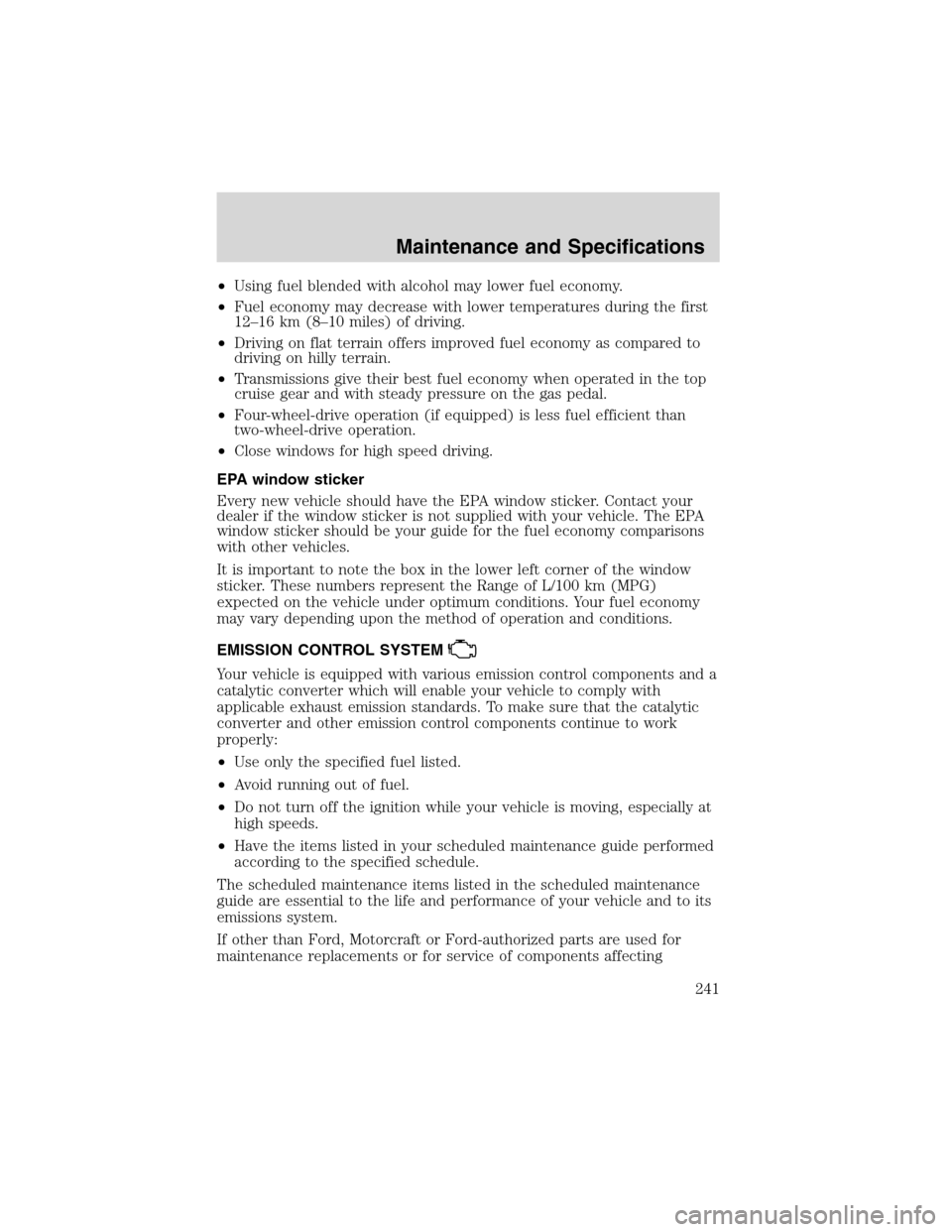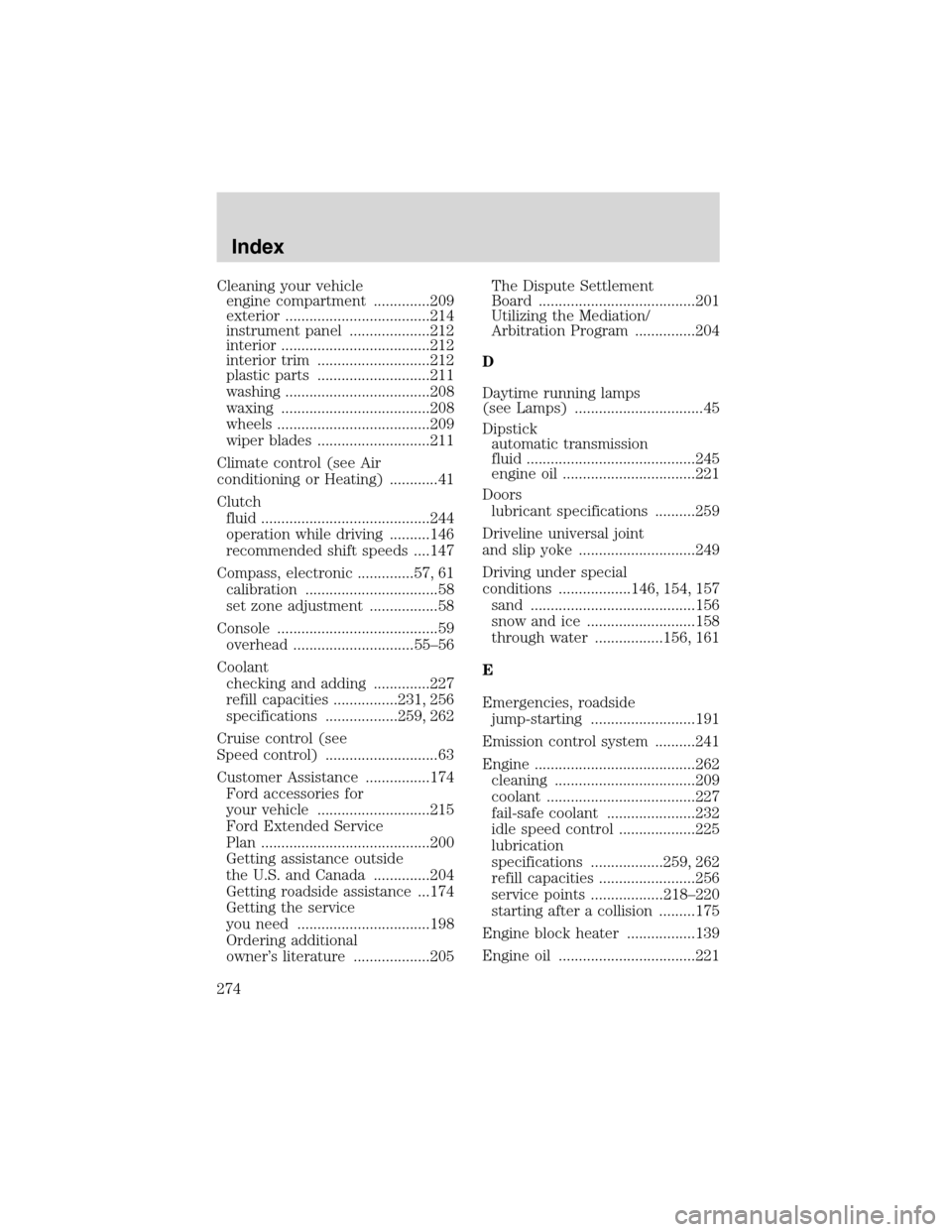2003 LINCOLN BLACKWOOD cruise control
[x] Cancel search: cruise controlPage 1 of 280

Introduction 4
Instrument Cluster 12
Warning and control lights 12
Gauges 16
Entertainment Systems 19
AM/FM stereo cassette 19
AM/FM stereo cassette with CD 25
AM/FM stereo with CD 28
Rear seat controls 35
Climate Controls 38
Manual heating and air conditioning 38
Electronic automatic temperature control 41
Rear window defroster 43
Lights 44
Headlamps 44
Turn signal control 46
Bulb replacement 48
Driver Controls 54
Windshield wiper/washer control 54
Power windows 60
Mirrors 61
Speed control (Cruise control) 63
Table of Contents
1
Page 14 of 280

Air bag readiness:If this light fails
to illuminate when ignition is turned
to ON, continues to flash or remains
on, have the system serviced
immediately. A chime will also
sound when a malfunction in the supplemental restraint system has been
detected.
Safety belt:Reminds you to fasten
your safety belt. A chime will also
sound to remind you to fasten your
safety belt.
Charging system:Illuminates when
the battery is not charging properly.
Oil pressure/Engine coolant:
Illuminates when any of the
following conditions has occurred:
•The engine coolant temperature
is high.
•The engine oil pressure is low.
Low fuel:Illuminates when the fuel
level in the fuel tank is at, or near
empty (refer toFuel gaugein this
chapter).
Low washer fluid:Illuminates
when the windshield washer fluid is
low.
Speed control:Illuminates when
the speed control is activated. Turns
off when the speed control system
is deactivated.
LOW
FUEL
CRUISE
Instrument Cluster
14
Page 66 of 280

Turning off speed control
There are two ways to turn off the speed control:
•Depress the brake pedal or the clutch pedal (if equipped). This will
not erase your vehicles previously set speed.
•Press the speed control OFF
control.
Note:When you turn off the speed
control or the ignition, your speed
control set speed memory is erased.
Indicator light
This light comes on when either the
SET ACCEL or RES controls are
pressed. The vehicle speed must be
at or above 48 km/h (30 mph). It turns off when the speed control OFF
control is pressed, the brake or clutch is applied, or the ignition is turned
to the OFF position.
ONE-TOUCH MOON ROOF (IF EQUIPPED)
•To open, press and release the
rear portion of the moon roof
control.
•To close, press and hold (as
desired) the front portion of the
moon roof control.
•To halt motion at any point
during one-touch opening, press
the control a second time.
•To tilt into the vent position
(when the glass panel is closed), press and hold the front portion of
the moon roof control. To close from the vent position, press and hold
the rear portion of the control until the glass panel stops moving.
•The moon roof has a sliding shade that can be manually opened or
closed when the glass panel is shut.
•To close the shade, pull it toward the front of the vehicle.
CRUISE
AUTO
ROOF
Driver Controls
66
Page 241 of 280

•Using fuel blended with alcohol may lower fuel economy.
•Fuel economy may decrease with lower temperatures during the first
12–16 km (8–10 miles) of driving.
•Driving on flat terrain offers improved fuel economy as compared to
driving on hilly terrain.
•Transmissions give their best fuel economy when operated in the top
cruise gear and with steady pressure on the gas pedal.
•Four-wheel-drive operation (if equipped) is less fuel efficient than
two-wheel-drive operation.
•Close windows for high speed driving.
EPA window sticker
Every new vehicle should have the EPA window sticker. Contact your
dealer if the window sticker is not supplied with your vehicle. The EPA
window sticker should be your guide for the fuel economy comparisons
with other vehicles.
It is important to note the box in the lower left corner of the window
sticker. These numbers represent the Range of L/100 km (MPG)
expected on the vehicle under optimum conditions. Your fuel economy
may vary depending upon the method of operation and conditions.
EMISSION CONTROL SYSTEM
Your vehicle is equipped with various emission control components and a
catalytic converter which will enable your vehicle to comply with
applicable exhaust emission standards. To make sure that the catalytic
converter and other emission control components continue to work
properly:
•Use only the specified fuel listed.
•Avoid running out of fuel.
•Do not turn off the ignition while your vehicle is moving, especially at
high speeds.
•Have the items listed in your scheduled maintenance guide performed
according to the specified schedule.
The scheduled maintenance items listed in the scheduled maintenance
guide are essential to the life and performance of your vehicle and to its
emissions system.
If other than Ford, Motorcraft or Ford-authorized parts are used for
maintenance replacements or for service of components affecting
Maintenance and Specifications
241
Page 274 of 280

Cleaning your vehicle
engine compartment ..............209
exterior ....................................214
instrument panel ....................212
interior .....................................212
interior trim ............................212
plastic parts ............................211
washing ....................................208
waxing .....................................208
wheels ......................................209
wiper blades ............................211
Climate control (see Air
conditioning or Heating) ............41
Clutch
fluid ..........................................244
operation while driving ..........146
recommended shift speeds ....147
Compass, electronic ..............57, 61
calibration .................................58
set zone adjustment .................58
Console ........................................59
overhead ..............................55–56
Coolant
checking and adding ..............227
refill capacities ................231, 256
specifications ..................259, 262
Cruise control (see
Speed control) ............................63
Customer Assistance ................174
Ford accessories for
your vehicle ............................215
Ford Extended Service
Plan ..........................................200
Getting assistance outside
the U.S. and Canada ..............204
Getting roadside assistance ...174
Getting the service
you need .................................198
Ordering additional
owner’s literature ...................205The Dispute Settlement
Board .......................................201
Utilizing the Mediation/
Arbitration Program ...............204
D
Daytime running lamps
(see Lamps) ................................45
Dipstick
automatic transmission
fluid ..........................................245
engine oil .................................221
Doors
lubricant specifications ..........259
Driveline universal joint
and slip yoke .............................249
Driving under special
conditions ..................146, 154, 157
sand .........................................156
snow and ice ...........................158
through water .................156, 161
E
Emergencies, roadside
jump-starting ..........................191
Emission control system ..........241
Engine ........................................262
cleaning ...................................209
coolant .....................................227
fail-safe coolant ......................232
idle speed control ...................225
lubrication
specifications ..................259, 262
refill capacities ........................256
service points ..................218–220
starting after a collision .........175
Engine block heater .................139
Engine oil ..................................221
Index
274